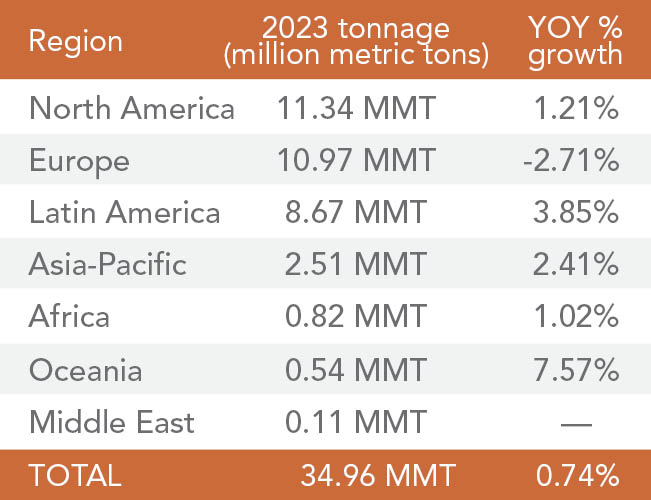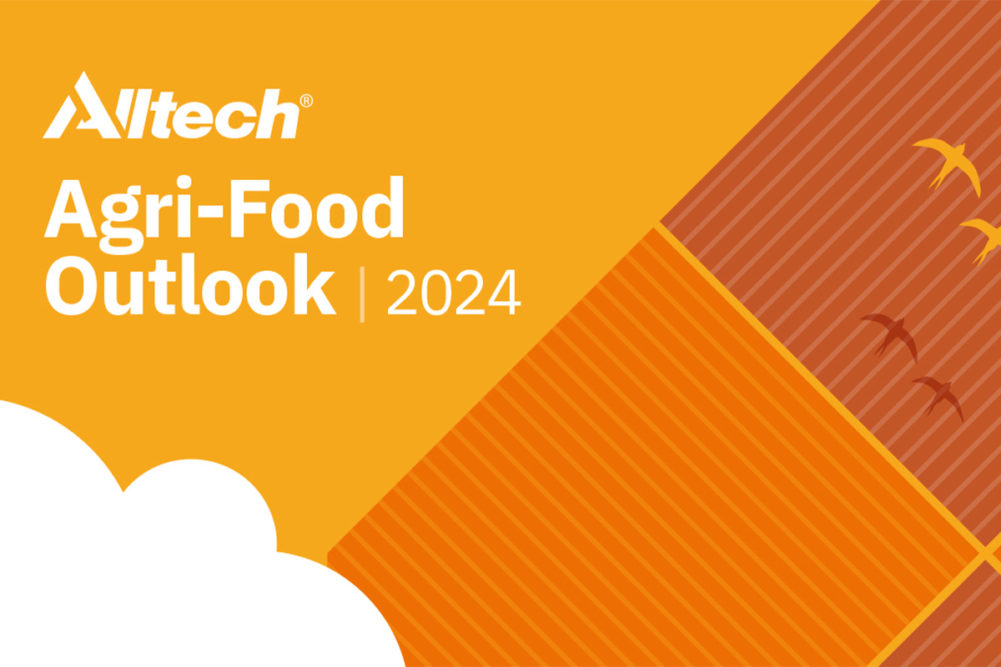LEXINGTON, KY. — Pet food was one of three animal feed categories, alongside broiler and layer feed, that posted global volume growth in terms of tonnage in 2023, according to Alltech’s 2024 Agri-Food Outlook shared April 2. Last year, global pet food volume amassed to 34.96 million tonnes, up slightly from 34.70 million tonnes in 2022.
The 13th annual survey, which includes data on global feed production for broiler, layer, pig, dairy, beef, aquaculture, pet and equine sectors, detailed a range of feed industry insights including regional trends impacting production volume and demand, as well as the number of feed facilities operating in each region.
North America surpassed Europe as the No. 1 pet food producing region worldwide in 2023. The continent produced 11.34 million tonnes of pet food product last year, up 1.21% from 11.20 million tonnes in 2022. Europe remains close behind with 10.97 million tonnes in 2023, but was the only region that posted a year-over-year decline. Pet food production in the region fell 2.71% from 11.28 million tonnes in 2022. This was largely attributed to supply chain challenges and economic pressures caused by inflation, Alltech shared.
Latin America posted solid growth in pet food production with 8.67 million tonnes in 2023, up 2.41% from 8.34 million tonnes in 2022. The Asia-Pacific region produced 2.51 million tonnes in 2023, up 2.41% from 2.45 million tonnes in 2022. These two regions in particular are expected to benefit from pet ownership trends in years to come, as pet owners in Latin America shift their focus to high-quality pet food products, and as more people in the Asia-Pacific region add pets to their households.
 Data source: Alltech 2024 Agri-Food Outlook; Graphic by Sosland Publishing Co. / Jordan Tyler
Data source: Alltech 2024 Agri-Food Outlook; Graphic by Sosland Publishing Co. / Jordan TylerThe highest growth rate by region went to Oceania, despite it being the second lowest in global pet food production. Oceania produced roughly 540,000 tonnes in 2023, up 7.57% from 500,000 in 2022. In Africa, pet food production totaled 820,000 tonnes in 2023, up 1.02% from 810,000 tonnes in 2022. The Middle East, which represented the smallest pet food production tonnage globally, was clocked at 110,000 tonnes in 2023, flat from 2022.
North America and Latin America are expected to drive most of the growth in the global pet food market moving forward, thanks in part to evolving consumer demands for the utmost quality, according to Alltech.
“The surge in pet ownership, especially post-pandemic, is contributing to the rising demand for high quality pet products and services,” Alltech stated in the report.
According to Alltech, just four countries are responsible for nearly half (49%) of global feed production — China, the United States, Brazil and India. In the US market, trends toward functional and targeted nutrition that address specific health concerns are expected to continue influencing growth of the pet food sector.
In 2023, US pet food production grew 1.31% from 2022 in terms of tonnage. Pet food production in China grew 6% from 2022 to 2023, and was up 6.18% in Brazil over the same period.
There are approximately 27,397 feed mills operating around the world, according to Alltech’s report. The Asia-Pacific region saw the greatest number of feed mills added from 2022 to 2023, totaling 481 new plants. In Africa, 150 new feed mills were established, bringing the region’s total to 2,188 mills. Additionally, 59 feed mills were added in the Middle East, bringing its total to 872. The number of feed mills in Oceania remained consistent from 2022 to 2023 at 195.
The number of feed mills declined across every other region from 2022 to 2023, with the most significant losses observed in China, Chile, the United States and Spain. North America lost 153 mills, bringing its total to 6,147; Latin America lost 186 feed mills, bringing its total to 4,080; and Europe saw the most drastic decline on a regional scale, losing 265 feed mills for a total of 6,288 remaining in 2023.
“The multiyear fall of the total number of feed mills in the world was halted in 2023 thanks, in large part, to India, where hundreds of additional feed mills were added over the past year,” Alltech stated in the report. “Still, while the total feed mill count is up by 0.3% (or 86 mills), the general trend from the past few years — of larger and, as a result, fewer feed mills — continued in many countries.”
Across the global feed sector, survey respondents also shared sentiments regarding impactful agri-food technologies. Respondents noted cutting-edge nutritional technologies that improve feed efficiency, address gut health, mitigate mycotoxins, and deliver enzymes and minerals are among some of the most pertinent today. On the processing side, drone technologies, artificial intelligence, automation/robotics and biosecurity were listed among the most important advancements for agri-food producers.
By region, Alltech suggested methane reduction technologies, regenerative agriculture and cost optimization are three key opportunities for continued growth in feed production in North America. Across the pond in Europe, manufacturers may also be looking to methane emission reductions, as well as carbon dioxide emission mitigation, soil health and R&D, as opportunities for growth.
“Smart farm technologies” is a key opportunity in the Asia-Pacific region, where aquaculture feed and pet food production are expected to continue to expand. In Latin America, gut health management was among the top three opportunities listed by respondents, as well as feed optimization and mycotoxin mitigation. Feed manufacturers in Oceania can look to reducing greenhouse gas emissions in ruminant production, and those in Africa can benefit from producing raw materials domestically rather than relying on imports.
Find the full 2024 Agri-Food Outlook report on Alltech’s website here.
Keep up with the latest pet food trends on our Trends page.



